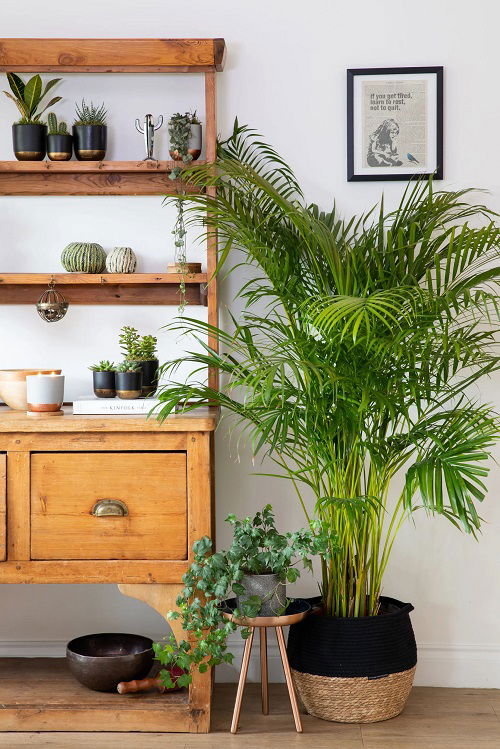Growing Areca Palm Indoors can be quite rewarding if you follow the right steps, and the plant will continue to thrive for a long time!
Transform your indoor spaces into tropical sanctuaries with the beauty of Areca Palms. Let us delve into the art of successfully growing and caring for these graceful and vibrant houseplants. Discover the secrets to Growing Areca Palm Indoors and creating a lush oasis inside your home, and enjoy the countless benefits of having this stunning palm as a captivating centerpiece.
Botanical Name: Dypsis lutescens
USDA Zones: Areca Palm growing zone is 9-11
Common Names: Golden Cane Palm, Butterfly palm, Chrysalidocarpus lutescens, Areca lutescens, Yellow palm
Learn How to Grow Parlor Palm Indoors here
Areca Palm Plant Information
Areca Palm, also known as the Butterfly Palm or Golden Cane Palm, is a popular indoor plant cherished for its graceful appearance and air-purifying qualities. Native to Madagascar, this palm species features feathery, arching fronds that add a touch of elegance to any interior space.
Wondering how fast do Areca Palms grow? With its moderate growth rate, the Areca Palm can reach a height of 6 to 10 feet (1.8 to 3 meters) indoors, making it a perfect choice for rooms with high ceilings. Its slender, bamboo-like stems create a visually appealing cluster, while the bright green foliage brings a refreshing tropical ambiance to your home or office.
With proper care, the Areca Palm will reward you with its stunning presence, helping to create a soothing and captivating atmosphere in your indoor space.
Check out our article on areca palm benefits here
How to Grow Areca Palm

- Select a healthy Areca palm seedling or start growing Areca Palm from seed by obtaining seeds from a reputable source.
- Choose a location with bright, indirect sunlight for your Areca palm. Prepare a well-draining potting mix consisting of equal parts peat moss, perlite, and sand.
- Select a suitable container with drainage holes and fill it with the potting mix.
- Plant the Areca palm seedling or sow the seeds in the potting mix, burying them about 1 inch deep.
- Water the soil thoroughly, ensuring it is evenly moist but not waterlogged, and place the container in a warm area with temperatures around 70-85°F (21-29°C).
- Provide indirect sunlight or partial shade to the Areca palm, avoiding direct exposure to harsh afternoon sun.
- Fertilize the palm every two to three months during the growing season with a balanced, water-soluble fertilizer.
- Enjoy the lush, tropical beauty of your Areca palm as it grows and flourishes.
Check out the Best Palm Trees in Florida here
Pot Size for Growing Areca Palm
Wondering how tall do Areca Palms grow? An indoor Areca palm can reach a height of 6-8 feet (1.8-2.4 meters), so you need to select the correct pot.
For a young or small Areca Palm, a pot with a diameter of around 6 to 8 inches (15 to 20 centimeters) would be suitable. This size allows for proper root development and prevents the plant from being overwhelmed by a large container.
As the palm grows, you will need to repot it into a larger container to accommodate its increasing size. A general guideline is to choose a pot that is 2 to 4 inches (5 to 10 centimeters) larger in diameter than the previous one. This allows the plant’s roots to have enough space to spread out and establish themselves.
Here are Plant Pot Sizes from Inches to Gallon
Requirements for Growing Areca Palm Indoors

Are Areca Palms easy to grow? Can Areca Palm grow indoors? Absolutely. Just ensure you maintain the following Areca Palm growing conditions when Growing Areca Palm Indoors.
Location
An Areca Palm must have just the right amount of light to thrive, you can’t keep it in a dark spot. The plant needs a full day, bright indirect light, it also loves gentle morning sunlight. Southern or Western exposure is good for it, but it’ll also do well in the East direction. Keep it within 4 feet of the window or door.
In winter, if the plant is placed too close to a window, make sure its leaves are not touching the windowpane. If the palm is placed in the harsh afternoon sunlight, its fronds will turn yellow.
Soil
Any neutral soil combination that is well-drained and porous will work. You can mix some amount of peat moss or coco-peat, perlite or sand, and organic matter like leaf mold or compost to enhance it.
Alternatively, you can mix two parts of regular potting soil, one part sand, half part compost, and half part coconut coir.
Learn some Great Tips to Rejuvenate Your Old Soil here
Watering
Proper watering is crucial for the Areca Palm. In the summer, water the plant frequently enough to keep the soil consistently moist. However, during fall and winter, allow the soil to dry out between waterings.
To determine when to water, check the soil by inserting your finger into it. If the soil feels dry, it’s time to water. Be cautious not to over-water, as this is a common cause of death for these palms.
Here are Signs of Overwatering & How to Save an Overwatered Plant
Temperature
As a tropical plant, the Areca Palm thrives in warm temperatures. Place it in a location away from drafts and sudden temperature fluctuations. The palm does best when the indoor temperature ranges between 60-80°F (15-27°C).
While it can tolerate colder temperatures down to 30°F (0°C), it is advisable to maintain the indoor temperature above 45°F (8°C) to ensure its safety.
Humidity
The Areca Palm thrives in the typical humidity levels found in most homes. However, if you notice the tips of its leaves turning brown, it may be an indication of dry air. Increase the humidity by misting the palm with water regularly.
Another method is to place the plant on a tray of pebbles filled with water. If you have a humidifier, it can be especially beneficial for maintaining an ideal humidity level for the palm’s health and well-being.
Here are 10 Ways To Increase Humidity For Houseplants That Work
Areca Palm Care Indoors
Fertilizer
To keep your Areca Palm healthy indoors, regular fertilization is important. During the growing season, which typically spans from spring to early fall, apply a balanced liquid fertilizer every two to four weeks.
Use a fertilizer specifically formulated for palms or a general-purpose houseplant fertilizer. It’s crucial not to over-fertilize, as this can lead to fertilizer burn and damage to the plant. Adjust the frequency and strength of fertilization based on the palm’s response and the specific fertilizer used.
Want to Make Organic Fertilizers from Kitchen Scraps? Click here
Pruning
Pruning is another essential part of caring for an indoor Areca Palm. Remove any yellow or brown fronds regularly to maintain the plant’s appearance and overall health. Use clean, sharp pruning shears or scissors to make clean cuts at the base of the fronds. Avoid cutting into the stem or trunk of the palm, as this can lead to damage.
Pruning not only enhances the palm’s aesthetic appeal but also allows for better airflow and reduces the risk of pest infestations.
Pests & Diseases
While Areca Palms are generally resilient, they can still be susceptible to certain pests and diseases when grown indoors. Common pests include spider mites, mealybugs, and scale insects. Regularly inspect the palm’s foliage, particularly the undersides of leaves, for signs of pests such as webbing, small crawling insects, or sticky residue.
If you notice an infestation, treat it promptly using an appropriate insecticidal soap or horticultural oil, following the product instructions. Additionally, be cautious of overwatering, as it can lead to root rot and other fungal diseases.
Here are 50 Types of Common Pests in Your Garden & How to Get Rid of Them
Frequently Asked Questions
1. Can an Areca Palm Grow From Cutting?
Areca Palms can be propagated from cuttings, but they typically have a lower success rate compared to other methods, such as division or growing from seeds.
2. Areca Palm Growing Season?
The growing season for Areca Palms is during the spring and summer months when they experience active growth and have higher nutrient and water requirements.
3. Can Areca Palm Grow in Low Light?
Areca Palms can tolerate low light conditions, but they prefer bright indirect light. They may survive in low-light areas, but their growth and overall health may be compromised.
4. Can Areca Palm Grow in Water?
Areca Palms are not well-suited for growing in water alone. They require well-draining soil to establish healthy root systems and thrive.
5. Can Areca Palm Grow Outside?
Areca Palms can be grown both indoors and outdoors. However, they are more commonly grown indoors as houseplants, where they can tolerate a wider range of environmental conditions.
6. Can Areca Palm Grow Without Roots?
Areca Palms cannot grow without roots. Roots are vital for nutrient uptake, water absorption, and anchoring the plant in the soil. Without roots, the palm would not be able to survive or grow.




thanks for that practical information.